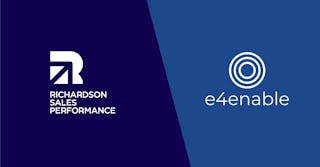Business Writing Tips for Sales Professionals
Prospecting

It’s no secret that today's buyers are tired, busy, and distracted. To capture their attention your sales team needs to build business writing skills that make their content worth the buyer’s time. Your team can achieve this by focusing on form and content while sticking to a three-part messaging structure.
Watch this video for a quick introduction to the best practices outlined in the blog below.
Focusing on Form and Content
Persuasive writing consists of strong form and content.
Content is what you say
Form is how you say it
Effective writers share a compelling idea – the content – through the use of simple sentences – the form. Writing with strong form and content requires an understanding of how both work.
Defining Good Form
Writing with good form is all about simplicity and clarity.
Using simple language allows the reader to use less brain power making it more likely that they’ll actually read the content.
Some best practices for writing with good form in business communications are:
- Express no more than one idea per sentence
- Use sentences of different lengths for variety
- Always use the shortest possible word
- Avoid clever similes, metaphors, and jargon
- Signpost content with subheadings
- Use the active voice
Defining Good Content
Writing compelling content Is about answering the question - “So What?”
Good content demonstrates the salesperson’s understanding of the customer’s needs by explaining how the solution adds meaningful value. Demonstrating this understanding requires a lot of thought and a confident point of view.
Some best practices for writing good content in business communications are:
- Think more and write less
- Use outcome-oriented language
- Develop an outline in advance
- Keep the message ultra-focused on the customer’s needs
- Address the question “so what” early in the text
- Ensure all parts of the writing align with the central message
- Revise the content until the thesis can be delivered in one sentence
Using a 3 Part Messaging Structure
A simple and powerful way to further ensure business communications are delivering good form and content is to adhere to a strict structure for writing the actual text.
The best 3-part structure for writing compelling business communications is:
01. Opening
In this section, the writer articulates their understanding of the customer’s challenges, outlines an action plan, and states the value of the outcomes.
02. Body
In this section, the writer expands upon the ideas in the opening, carefully focusing on key information and making logical connections between challenges, solutions, and value.
03. Conclusion
In this section, the writer makes the message memorable, this is a good place to call out differentiators to help the customer feel how the solution will improve their business.
This outline might seem obvious but executing it in practice can be a challenge.
Review the two examples below to see the difference between effective and ineffective business writing for sales professionals.
Examples of Ineffective and Effective Business Writing for Sales Professionals
Ineffective Business Writing Example
Consider the following excerpt from an RFP where the sales professional is responding to a financial services business that is interested in the seller’s data visualization software, Specto:
As an exceptional leader in the SaaS space our game-changing, cloud-based software leverages data to generate insights that drive revenue for superior control over the performance of the financial and operational aspects of your business.
Here, the writer makes a few decisions that diminish the clarity of the opening:
- The words "exceptional,” “game-changing,” and “superior” are all unnecessary
- The description of the software is vague
- The sentence is long and doesn’t put the customer first
Our technology breaks free of the colocation problem and streamlines the analysis of financial data without succumbing to overfitting while ensuring privacy through the anonymization of data. The result is a best-in-class solution that gives you control over the performance of your business.
With our software executives benefit from automated aggregation. Traditional data analysis requires nearly 40 hours per week. The result is an astounding 20-30% loss in productivity. As a result, business costs rise up to 15%. Over 2,000 different sources are united by our data.
In the body, the writer has further diluted their message by doing the following:
- The first sentence covers too many different topics
- “Colocation,” “overfitting,” and “anonymization” are all jargon
- The salient points are lost in too many numbers
- The sentences are long and lack variation
- The last sentence uses the passive voice
You have the puzzle pieces, but you need the resources to assemble them. This is a problem because the financial services industry is competitive as customers expect lower fees and an array of free services. Financial planning, budgeting, investment return forecasting, asset allocation, and credit monitoring are all core offerings for any major financial services firm. Delivering those capabilities means being able to render a dimensional picture of the customer’s needs. We offer the power of data-driven insights that accomplish real-time insights allowing you to identify and address the customer’s unserved needs while achieving operational efficiencies that drop to the bottom line. As a result, your business can focus on providing financial services which include investment guidance, spending insights, and debt management.
In the closing, the writer does not succeed in driving lasting impact because:
- The first sentence appears too late. It should be the first of the RFP
- The end of the paragraph requires “first, second, third” signposting
- The ideas are disconnected and do not flow
- The paragraph is too long, making it difficult to read
- The content explains financial services which the customer already knows
Effective Business Writing Example
Now consider how the revised text improves the RFP:
You have the pieces, but you need the resources to assemble them.
Distilling insights from data is critical as three key trends emerge in the financial services industry.
First, customers increasingly seek low or zero fees which puts pressure on operational costs. Second, forecasting the customer’s financial needs requires a more sophisticated reading of demographic data. Third, meeting new compliance regulations requires faster data retrieval. Addressing all of those challenges means yielding more value from existing information.
That’s where we come in.
This opening captures the reader's attention because it:
- Starts with one sentence expressing one clear idea
- Uses clear signposting
- Puts the focus on the customer
- Has a logical flow and clear conclusion
- Is divided into short paragraphs
Our software visualizes one of your strongest assets: data. We use automation to unite up to 2,000 different sources of information. The result is a fast and accurate reading of your data. Information becomes action. Insights create scalable operational efficiencies. Those efficiencies drive profitability.
These profitability gains add up. Our customers, on average, experience a 15% increase in revenue. For many, that number continues to grow as they discover ways to scale the insights we provide through our software. This scalability is possible because we enable you to manage data virtually while knowing that the information has been scrubbed of all identifying details.
In this short body section, the author shares additional information in a compelling manner by:
- Using an active voice to keep the reader engaged
- Ensuring each idea flows into the next
- Using a varied sentence structure
- Shortening the text to make it more readable
- Using a single relevant statistic
- Translating complex words like "colocation,” and “anonymization” into more simple language
Specto is how sand becomes a castle.
In the closing section, the writer leaves the reader with a key takeaway that is memorable and evokes emotion.
Click here to visit our YouTube channel for more tips to improve your team's sales performance.

Article: Sales Capabilities Required to Compete Today
DownloadGet industry insights and stay up to date, subscribe to our newsletter.
Joining our community gives you access to weekly thought leadership to help guide your planning for a training initiative, inform your sales strategy, and most importantly, improve your team's performance.






